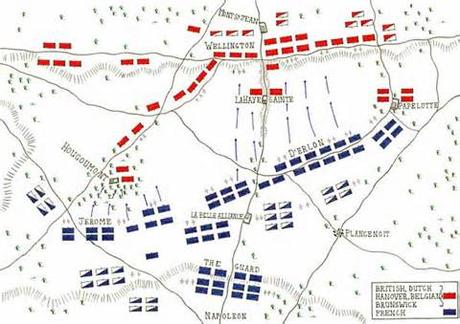Sorry, sorry, but this is the historical equivalent of a tiny pebble in my shoe. It has, off and on, niggled away at me for years. Next week I am giving a talk on the battle of Waterloo - yes, darlings, thank your lucky stars you're nowhere near! - and that same irritating question arises in what passes for my mind yet again.
In considering the battle it is essential to realize that if Wellington had been God he would have designed a battlefield pretty much like the one at Mt. St. Jean where he finally came face to face with Bonaparte. It was nigh on perfect for the business of fighting a defensive, holding battle:

The road running from south to north through the center was the direct route to Brussels. The battlefield area is a very shallow valley - if you drove along the road you would barely realize that you had dipped into a depression and come up the other side. Only a soldier's eye would have spotted its significance. It suited Wellington perfectly because he had long realised from his experience in Spain that where-ever possible it was prudent to place your troops behind a ridgeline so that they may escape the worst of the enemy's artillery.
In addition it had three extra 'goodies' from Wellington's point of view. If you check the map again you will see three advanced positions sitting well into 'no man's land'. On the left (as you look at the map) there is the large, thickly-walled chateaux/farmhouse called Hougoumont. This was to suck in more and more and yet more French troops led by Bonaparte's younger brother, Jerome, in an utterly futile and costly attempt to take it. Jerome's over-enthusiasm (shall we call it?) was to deprive Bonaparte of a functioning left wing.
In the center is the smaller but equally tricky farmhouse of La Haye Saint which stood well in front of Wellington's front line and acted as, in effect, a breakwater on the advancing French who, though they took it in the end, wasted hours doing so. Over on the right was the village of Papelotte on which Wellington could hook his left wing as he waited for the Prussians to arrive from that direction.
So, you don't need to be a Clausewitz to see that that little valley was perfection for Wellington but my (obscure, I know!) question is, who spotted it and when? 'General knowledge'(!) has it that Wellington noted it whilst recce-ing south of Brussels in 1814 - but as far as I can tell he wasn't in Belgium in 814! And anyway, with Bonaparte locked up in Elba why would he bother? The war was over!
I seem to remember reading somewhere that the potential of the field at Waterloo was noted by Wellington, or by his staff, early in 1815 when he was sent over to command allied forces following Bonaparte's sudden return. I am ashamed to say that I cannot find a biography of Wellington which I am sure I once had, but then again, it's amazing how my history books disappear mysteriously every time 'SoD' (Son of Duff) visits, although he denies everything - that boy should have been a lawyer!
Anyway, I am forced to appeal to you, my, er, 'mass' readership who, like the British army at Waterloo, might lack numbers but make up for it in 'know-how'! Who was it who first spotted the potential of the field at Waterloo and when?
